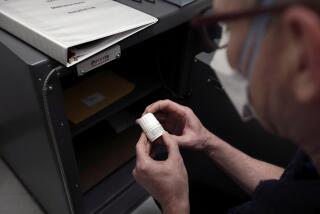Lab Animals ‘Critical Part’ of Research, Report Holds
Laboratory animals, including those obtained from pounds and shelters, are a “critical part” of human health care research and scientists are “morally obliged” to continue using them, according to a controversial report released Tuesday by a committee of the National Academy of Sciences.
“The chance that alternatives will completely replace animals (for research) in the foreseeable future is nil,” the committee said. But the committee also noted that, “scientists are ethically obliged to ensure the well-being of animals used in research and to minimize their pain and suffering.”
The report takes issue with many animal welfare groups, which argue that animals are not necessary for many types of research and that those that are needed are frequently abused or simply given inadequate care.
The committee was split on several issues, however, and dissenting statements from two of the 15 committee members were included in the report. Physiologist Arthur C. Guyton of the University of Mississippi wrote that the report “fails to make clear how seriously the animal rights movement and increasing government regulation are impeding essential medical research.”
Another committee member, Christine Stevens of the Animal Welfare Institute in Washington, who refused to sign the report, wrote that it “refuses to face the widespread, ingrained problem of unnecessary suffering” of laboratory animals.
Animal welfare groups were disappointed with the report.
“It looks like a description and endorsement of the status quo,” said biologist Martin Stephens of the Humane Society of the United States. “I’m surprised it took three years to produce this document. It contains very standard statements that they could have put together in an afternoon.”
The committee’s chairman, chemist Norman Hackerman of Rice University, conceded that “this report will not end debate about the use of animals. . . . We believe, however, that the report provides a . . . point of departure for further discussion on how to use animals appropriately.”
The number of laboratory animals used in the United States each year is debatable. A census of such animals was supposed to be incorporated in the committee’s deliberations, but contractual difficulties delayed its completion.
The committee thus relied on previous estimates that 17 million to 22 million mammals, birds, reptiles, amphibians and fish were used for research in 1983, the most recent year for which information is available. Between 12 million and 15 million of those animals were rats and mice.
Furthermore, the panel noted, “it is not even possible to tell from the existing data whether the total number of animals used each year is increasing or decreasing.”
All but the most adamant animal rights groups acknowledge that some animal research is necessary and beneficial in both human and veterinary medicine. The primary issues now are the sources of animals, whether existing laws are adequate to ensure that research animals are treated humanely and whether technological advances can minimize animal use. The committee concluded that technological alternatives were still very limited, but was divided on the other issues.
Controversial Area
One of the most controversial areas of discussion, for example, involves the use of animals from pounds and shelters. Each year, according to the report, more than 10 million cats and dogs are destroyed at such shelters, while fewer than 200,000 are released from these sources to researchers. Twelve states have passed laws prohibiting the release of impounded animals for research.
The committee unanimously recommended that pound animals be made available for research in which the animals remain anesthetized until they are killed, but were divided about longer experiments. A majority of the committee supported the use of pound animals in all types of research, while a minority opposed their use in certain experiments, such as drug or carcinogen testing, that extend over prolonged periods.
The committee was also split on a recommendation to extend the protection of the Animal Welfare Act--which was passed in 1966 and amended in 1970, 1976 and 1985--to rats, mice, birds and farm animals, the only animals not currently covered. The act stipulates that the animals received adequate cage space, food and water, among other considerations. The group originally voted 6 to 5 in favor of the extension, Stevens said in an interview, then reversed itself in a later meeting at which she was not present.
Urge Funds for Inspections
The committee also concluded that no new animal-welfare legislation was necessary, but urged that Congress appropriate more money “for the inspections required for the enforcement of the Animal Welfare Act” and for the improvement of animal care facilities.
The panel also criticized activists who vandalize laboratories and “liberate” animals and oppose the concept of “animal rights.”
“We feel animals have an inherent value, but we did not find them, in the general public definition of the term, to have rights,” said committee member James Wall, editor of the Christian Century newspaper in Chicago.
More to Read
Sign up for Essential California
The most important California stories and recommendations in your inbox every morning.
You may occasionally receive promotional content from the Los Angeles Times.










